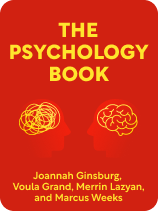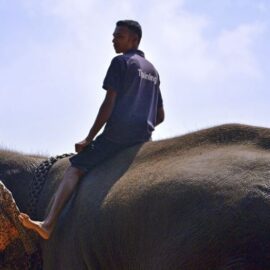

This article is an excerpt from the Shortform book guide to "The Psychology Book" by Catherine Collin, Nigel Benson, et al.. Shortform has the world's best summaries and analyses of books you should be reading.
Like this article? Sign up for a free trial here.
What is the history of developmental psychology? How do children’s minds grow into those of adults?
How humans grow from children to adults was actually widely misunderstood until the 1930s. It wasn’t until Jean Piaget came along that people finally began to understand how cognitive processes change over time.
Find out more about these changes with the help of The Psychology Book‘s description of developmental psychology history.
Developmental Psychology: The Mind From Infancy to Adulthood
The authors explain that prior to the 1930s, the general belief was that children are just miniature versions of adults and that the main psychological difference between children and adults was a lack of knowledge due to age. This belief was challenged by Swiss psychologist Jean Piaget, who argued that children’s cognitive processes are different from those of adults. This led to the field of developmental psychology, or the study of how the brain changes over the course of a lifetime, including the forming of attachments, learning, and developmental disorders, among other things. We’ll discuss some of the most influential concepts and figures below to understand developmental psychology history.
(Shortform note: Because the historical view of children was that they were miniature adults, the concept of childhood wasn’t established in Western society until around the 1600s. Before that, children as young as seven were treated as small adults, with the accompanying expectations for labor. Marriage and reproduction before the age of 18 were also the norm, particularly for girls. The emergence of developmental psychology helped distinguish children from adults, and some say this distinction has led to greater protections of children’s rights and safety.)
Piaget: The Father of Developmental Psychology
Piaget theorized that children pass through stages of cognitive development, using their senses and natural curiosity to learn through trial and error. The four stages he identified were:
1) The sensorimotor stage (birth to age 2). Children use their senses and physical actions to learn about their environment, and they’re unable to understand perspectives other than their own.
2) The pre-operational stage (ages 2-7). Children begin to understand things like symbols and language.
3) The concrete operational stage. Children gain the ability to think logically about physical objects.
4) The formal operational stage. Children learn to conceptualize ideas and can reason about abstract concepts.
(Shortform note: The authors don’t give an age range for Piaget’s third and fourth stages, but according to other sources, the concrete operational stage ranges from 7 to 11 years old and the formal operational stage ranges from 11 years old through adulthood.)
Piaget’s theories shifted the focus of the education system from adult-centered (trying to teach children to be adults) to child-centered (meeting children at their level of development and encouraging individuality, creativity, and exploration).
| Criticisms and Misinterpretations of Piaget’s Theory Some have criticized Piaget’s theories for overestimating the abilities of adolescent children and underestimating the abilities of infants and for Piaget’s potential bias in studying his own children as subjects. There are also criticisms of the stages themselves: Some suggest that not everyone moves through all four stages and that some people may stay in the concrete operational stage throughout their adulthood. Some also dispute the idea that children in the first two stages can’t understand the perspective of others. Additionally, some have misinterpreted Piaget’s suggestion that education should be child-centered by assuming that direct instruction should never be used, despite cognitive science research suggesting the contrary. |
Learning Through Social Interaction and Modeling
The authors explain that later researchers adapted and expanded on Piaget’s initial ideas. While Piaget believed that children learn mostly through interaction with their environment, Russian psychologist Lev Vygotsky felt that learning was more dependent on social interaction. He also developed the theory of the zone of proximal development, which is the idea that children need help from an adult or older child to learn how to do certain things. The zone of proximal development is the area of learning that’s accessible to a student with such assistance (as opposed to what the learner can do without assistance or what they can’t do even with assistance), and this theory prompted a greater emphasis on cooperative learning in the education system.
(Shortform note: Vygotsky’s theory of learning and the zone of proximal development have led to an emphasis on the practice of scaffolding in education. Educators scaffold by providing activities to children that are challenging but within their capabilities, while controlling the factors that are beyond the child’s capabilities. This type of teaching has to be highly individualized and requires a deep knowledge of a child’s abilities and cognitive level. It also requires a large time commitment for planning, which can make it difficult to implement effectively in a classroom setting.)
Canadian-American psychologist Albert Bandura was also interested in how children learn, particularly how they pick up behaviors such as aggression, which he felt couldn’t be adequately explained by behaviorist theories like operant conditioning. He believed that humans learn behavior by watching others and mimicking their actions, an idea known as the social learning theory (in contrast to reinforcement theory in behaviorism, which suggests that they learn from rewards and punishments).
(Shortform note: Subsequent experiments that Bandura carried out demonstrated that punishment may play a role in how likely someone is to mimic a behavior they’ve seen modeled: When children saw someone behaving aggressively and then being punished for it, they were less likely to imitate the behavior. However, if someone asked them to mimic the behavior, they did, suggesting that they had learned the behavior, but seeing someone punished for it taught them that they shouldn’t engage in that behavior.)

———End of Preview———
Like what you just read? Read the rest of the world's best book summary and analysis of Catherine Collin, Nigel Benson, et al.'s "The Psychology Book" at Shortform.
Here's what you'll find in our full The Psychology Book summary:
- Psychology 101 without the classrooms and dry lectures
- A look at the various fields of psychology and how they've changed
- Context, criticisms, and limitations of certain theories






